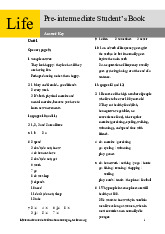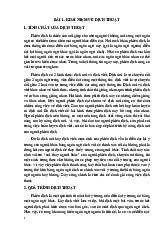




Preview text:
LESSON PLAN
TIẾNG ANH 11 FRIENDS GLOBAL
UNIT 1: SUSTAINABLE HEALTH
LESSON 3E - WORD SKILLS: WORD FAMILIES I. OBJECTIVES
By the end of this lesson, Ss will be able to: 1. Knowledge
- Gain trivial knowledge about how emotions affect the body.
- Know some adjectives to describe feelings and their related nouns and adverbs. 2. Competences
- Understand an article about how emotions affect the body. - Discuss their emotions.
- Present their opinions on some statements about emotions.
- Develop self-study skills, collaborative skills and critical-thinking. 3. Personal qualities
- Build an awareness of one’s emotions.
- Be collaborative and supportive in pair work and teamwork.
- Actively join in class activities. II. MATERIALS
- Grade 11 textbook, Unit 3, Word skills
- Computer connected to the Internet - Projector / TV - PowerPoint Unit 3E III. PROCEDURES
1. ACTIVITY 1: WARM-UP/LEAD-IN (8 mins) a. Objectives:
- Introduce the new lesson and set the scene for Ss to acquire new language.
- Get students' attention at the beginning of the class.
- Activate background knowledge.
- Students can gain more confidence and interest in the lesson. b. Content: - Feel the sounds (Game). - Exercise 1. (p.41) c. Products:
- Students listen and guess the sounds.
- Ss talk to their friends about the situations. d. Organisation
TEACHER’S AND STUDENTS’ ACTIVITIES CONTENT Feel the sounds (3 mins)
- T goes through the instruction. Answers:
- Ss listen to the sounds and work in pairs to guess how 1. Afraid /scared/ fearful the people feel. 2. Sad / upset / depressed
- Ss with the correct answer brings points to their group 3. Happy / joyful / cheerful or get a present. 4. Disappointed
- T asks: “In what situations would you experience these 5. Disgusted
emotions?” and elicits a few answers.
Exercise 1: In pairs, read the adjectives below and talk about situations in which you experience those feelings (5 mins)
- T goes through the word list to check the meaning and Adjectives to describe feelings:
pronunciation of the adjectives. afraid anxious ashamed cross
- T gives examples based on personal experiences. disgusted envious proud
- In pairs, students discuss situations in which they experience the feelings.
Example: I sometimes feel afraid if I see a
- A few students volunteer to share their ideas with the very large spider. class. e. Assessment
- Teacher observes the groups and give feedback.
2. ACTIVITY 2: PRESENTATION (17 mins) a. Objectives:
Students learn the form, pronunciation and when to use vocabulary related to the topic. b. Content: - Pre-teach vocabulary. - Exercise 2. (p.41) - Exercise 3. (p.41) - Exercise 4. (p.41) c. Products:
- Ss discuss with their friends, do exercises in the book and say aloud the new vocabulary items d. Organisation
TEACHER’S AND STUDENTS’ ACTIVITIES CONTENT
Pre-teach vocabulary (5 mins)
- T goes through the slides and elicits the words from 1 disgust /dɪsˈɡʌst/ (n.) the pictures first. 2 envy /ˈenvi/ (n.)
- T conducts oral drill chorally and individually. 3 contempt /kənˈtempt/ (n.)
- T asks CCQs to check Ss’ understanding.
4 depression /dɪˈpreʃn/ (n.)
- Ss answer and take notes of new vocabulary. 5 gut /ɡʌt/ (n.)
- Ss work in pairs to complete the matching exercise on
the slide to learn more vocab for the listening
-T goes through the slides again to check pronunciation.
Exercise 2: Read the article and look at the pictures. Match the underlined words in the article with pictures 1–4. (5 mins)
- T focuses Ss’ attention on the title. Answer: 1 anger
- On the board, write the following: I’ve got a gut 2 happiness
feeling that our team is going to lose today. Ask: What 3 depression
do you think ‘gut feeling’ means? (a feeling based on 4 shame
emotions rather than thought and reason)
- Students read the article and match the underlined words with pictures 1–4.
- T checks answers as a class.
Exercise 3: Complete the tables with words from exercises 1 and 2. (2 mins)
- Students complete the table. Answer:
- T checks answers as a class.
1 anger 2 anxious 3 shame 4 envy
5 happiness 6 proud 7 sadness 8 surprise
Exercise 4: Read the Learn this! box. In pairs, write down two more examples for each rule (a–d).
Use a dictionary to help you if necessary. (5 mins)
- Ss read the Learn this! box and find two examples for Possible answers: each of the rules in pairs.
a tired – tiredness, merry – merriment
- T elicits some answers and then invites some Ss to
b excited, exciting, dangerous, useful,
write the examples on the board. harmless, funny, typical
- T checks and gives more examples if necessary. c slowly, differently
d tidily – untidily, possible – impossible e. Assessment
- Teacher checks students’ pronunciation and gives feedback.
- Teacher checks students’ understanding of vocab and gives feedback.
- Teacher observes Ss’ writing of vocabulary on their notebooks.
3. ACTIVITY 3: PRACTICE (10 mins) a. Objectives:
- Ss can use different word forms of the adjectives they have learned b. Content: - Exercise 5. (p.41) c. Products:
- Students complete the exercises in their books correctly. d. Organisation
TEACHER’S AND STUDENTS’ ACTIVITIES CONTENTS
Exercise 5: Complete the sentence with the adjective or adverb related to the noun in brackets. You may need to add a prefix.
- T asks students to look at the position of each word Answers:
and decide if it is an adjective or an adverb.
1 angrily 2 hopeful 3 surprised 4 anxiously
- Students complete the sentences. 5 sadly 6 ashamed 7 enviously
- Ss check their answers with their friends.
8 unsurprising 9 annoyingly 10 unhappiness
- T invites some Ss to write their answers on the board and then corrects. e. Assessment
- Teacher’s feedback and peers’ feedback.
4. ACTIVITY 3: PRODUCTION (10 mins) a. Objectives:
- Ss express their opinions on some statements about emotions.
- SS talk to their friends about related situations. b. Content: - Four Corners - Exercise 6. (p.41) c. Products:
- Students discuss, take notes and report orally. d. Organisation
TEACHER’S AND STUDENTS’ ACTIVITIES CONTENT FOUR CORNERS (5 mins)
- T goes through the instruction in the slide.
1 Money can make people happy.
- Ss will see 3 statements. For each statement, think for 2 Pride is always good.
a minute and choose one of the following corners: 3 Fear is a good emotion.
Strongly agree Agree Disagree Strongly disagree
- Ss then talk to the members of their corners then share
their group’s opinions with the whole class.
- T monitors and helps Ss with the language they need.
Exercise 6: Discuss the questions in pairs.
- In pairs, students take turns to ask and answer the
1 Do you think money can make people questions. happy? Why? / Why not? - T circulates and monitors.
2 When is pride good? When is it bad?
- T invites some Ss to share their ideas with the class.
3 Is fear ever a good emotion? If so, when? e. Assessment
- Teacher observation on Ss’ performance.
- Teacher’s feedback and peers’ feedback. 5. CONSOLIDATION (3 mins) a. Wrap-up
- If T is using the Classroom Presentation Tool, first do the lesson closer to review what has been covered in this lesson.
- T asks students: What have you learned today? What can you do now? and elicits answers: I
can describe and discuss feelings. I can form nouns, adjectives and adverbs from the same stem b. Homework
- Prepare for the next lesson




